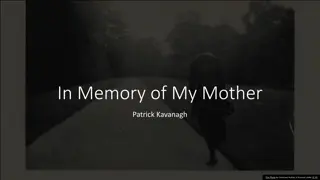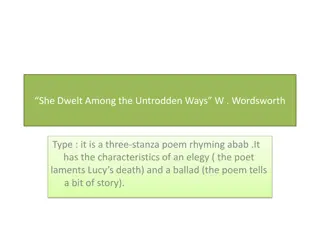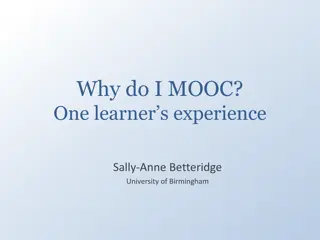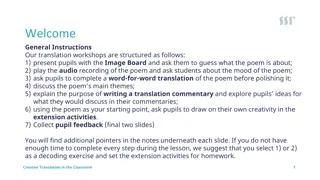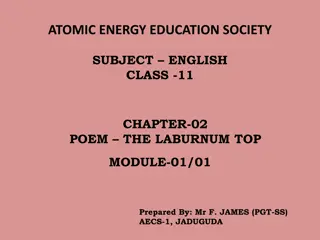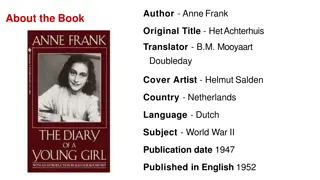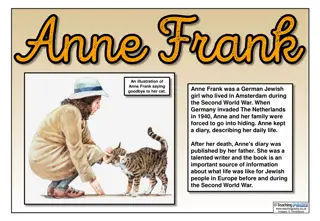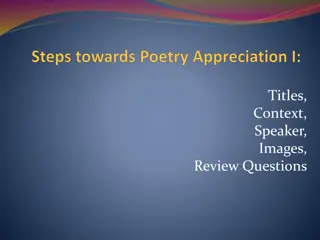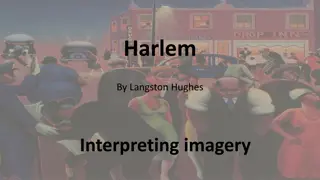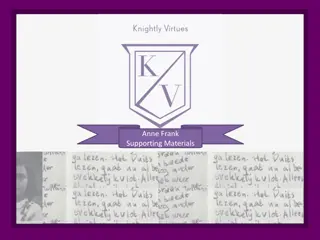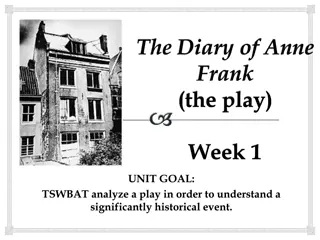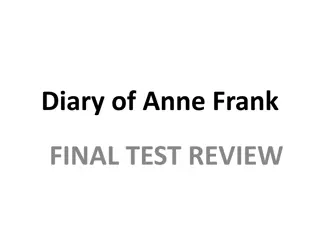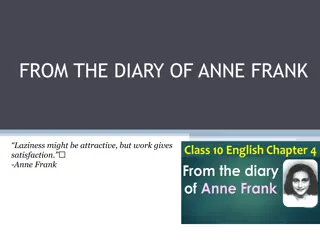Exploring Anne Bradstreet's Poem "The Author to Her Book
Dive into Anne Bradstreet's poem "The Author to Her Book" and analyze how the controlling metaphor used expresses the intricate emotions of the speaker towards her work. Discover the poetic elements and techniques employed by Bradstreet to convey the speaker's complex tone in this timeless piece of literature.
Download Presentation

Please find below an Image/Link to download the presentation.
The content on the website is provided AS IS for your information and personal use only. It may not be sold, licensed, or shared on other websites without obtaining consent from the author. Download presentation by click this link. If you encounter any issues during the download, it is possible that the publisher has removed the file from their server.
E N D
Presentation Transcript
Using Released Student Samples for your students to revise and improve utilizing the new rubric Adapted from a presentation by Tammy Schoen, Coral Glades High School, Coral Springs, Florida Thank you.
1996 Poem: The Author to Her Book (Anne Bradstreet) Prompt: Read carefully the following poem by the colonial American poet, Anne Bradstreet. Then write a well-organized essay in which you discuss how the poem s controlling metaphor expresses the complex attitude of the speaker. The Author to Her Book by Anne Bradstreet Thou ill-form d offspring of my feeble brain, Who after birth did st by my side remain, Till snatcht from thence by friends, less wise than true Who thee abroad, expos d to publick view; Made thee in rags, halting to th press to trudge, (5) Where errors were not lessened (all may judge) At thy return my blushing was not small, My rambling brat (in print) should mother call, I cast thee by as one unfit for light, Thy visage was so irksome in my sight; (10) Yet being mine own, at length affection would Thy blemishes amend, if so I could: I wash d thy face, but more defects I saw, And rubbing off a spot, still made a flaw. I stretcht thy joints to make thee even feet, (15) Yet still thou run st more hobbling than is meet; In better dress to trim thee was my mind, But nought save home-spun cloth, i th house I find. In this array, mongst vulgars mayst thou roam In critics hands, beware thou dost not come; (20) And take thy way where yet thou art not known, If for thy father askt, say, thou hadst none: And for thy mother, she alas is poor, Which caus d her thus to send thee out of door.
Stable Wording In the following poem The Author To Her Book by Anne Bradstreet, (published in 1650), the speaker using a controlling metaphor to discuss the relationship between an author and her work. Read the poem carefully. Then, in a well- written essay, discuss how Bradstreet uses poetic elements and techniques to convey the complex tone of the speaker. Information on stable prompts can be found on page 138 of the CED
In the following poem The Author to Her Book by Anne Bradstreet, (published in 1620), the speaker use a controlling metaphor to discuss the relationship between an author and her work. Read the poem carefully. Then, in a well-written essay, discuss how Bradstreet uses poetic elements and techniques to convey the complex tone of the speaker. The Author to Her Book by Anne Bradstreet Thou ill-form d offspring of my feeble brain, Who after birth did st by my side remain, Till snatcht from thence by friends, less wise than true Who thee abroad, expos d to publick view; Made thee in rags, halting to th press to trudge, (5) Where errors were not lessened (all may judge) At thy return my blushing was not small, My rambling brat (in print) should mother call, I cast thee by as one unfit for light, Thy visage was so irksome in my sight; (10) Yet being mine own, at length affection would Thy blemishes amend, if so I could: I wash d thy face, but more defects I saw, And rubbing off a spot, still made a flaw. I stretcht thy joints to make thee even feet, (15) Yet still thou run st more hobbling than is meet; In better dress to trim thee was my mind, But nought save home-spun cloth, i th house I find. In this array, mongst vulgars mayst thou roam In critics hands, beware thou dost not come; (20) And take thy way where yet thou art not known, If for thy father askt, say, thou hadst none: And for thy mother, she alas is poor, Which caus d her thus to send thee out of door.
Sample Thesis As a struggling writer, fighting for perfection, Anne Bradstreet compares her poorly composed work to a deformed child. She begins by saying her writings were not alive to her after she bore them; it was not ready for anyone else to see it. The ambition of the narrator s friends for her caused others to view her work prematurely. Her poorly edited composition was sent to the press full of errors and scars, which embarrassed and shamed her. embarrassed and shamed her. Complex?
Student Revision #1 #1 As a struggling writer, fighting for perfection, Anne Bradstreet compares her poorly composed work to a deformed child. She begins by saying that her writings were not alive to her after she bore them; it was not ready for anyone else to see it. The ambition of the narrator s friends for her caused others to view her work prematurely. Her poorly edited composition was sent to press full of errors and scars, which embarrassed and ashamed her. This poem helps the reader to understand the balance between finances and perfectionism that authors must face every time they release a book. No, but they have, perhaps, introduced some discussion that could lead to the sophistication point. Is this a discussion of tone? Illuminating the student s interpretation by situating it within a broader context.
Student Revision #2 #2 As a struggling writer, fighting for perfection, Anne Bradstreet utilizes an extended metaphor to compare her poorly composed work to a deformed child. She begins by saying that her writings were not alive to her after she bore them; it was not ready for anyone else to see it, which demonstrates that she is not satisfied with what she has written so far. The ambition of the narrator s friends for her caused others to view her work prematurely, and this makes the speaker self-conscious about the work she has put out for others to judge. Her poorly edited composition was sent to press full of errors and scars, which embarrassed and ashamed her. These feelings of embarrassment and shame turned to frustration and anger as she thinks of her failed attempts at making her work perfect. However, just as a mother feels she must love her child, the speaker is held by the obligation to love her creation and, as a poor writer, the speaker must also accept the imperfection of her work and publish it to receive payment. The student has moved more closely to complexity. A bit more depth. The student begins to introduce the authors struggles to strive for perfection. Ideally, we might want to have student 1 and 2 work together on another revision.
Student Sample from 1996 As a struggling writer, fighting for perfection, Anne Bradstreet compares her poorly composed work to a deformed child. She begins by saying that her writings were not alive to her after she bore them; it was not ready for anyone else to see it. The ambition of the narrator s friends for her caused others to view her work prematurely. Her poorly edited composition was sent to press full of errors and scars, which embarrassed and ashamed her. She calls her work a rambling brat with an irksome .visage. It becomes ugly an ugly and burdensome task, which she must love because it is her own, as a mother must love her children. She attempts to bathe and clean her offspring as any mother would clean her own child. Though the load and work for her burden is cumbersome, she must continue. She must nurture and attempt to remedy her creation so that it may run instead of carry on at a slow, measured pace. She tries to clothe it in something better than rags but finds that she cannot find what will help her work succeed. She tells her child to go where it is unknown; it has no father and a poor mother as an excuse to its ugliness and flaws. She feels ashamed because she is helpless and cannot perfect her offspring. Bradstreet s metaphor of her book s being a child is effective because it demonstrates the stress and frustration the narrator feels toward perfecting her work to meet her own ideas of perfection. By nature, a mother must unconditionally love a child, even though it may cause embarrassment or shame to her. The narrator finds that she cannot love her offspring because of its blemishes. She tries to correct the deformities of her creation, which becomes an endless task of fixing one only to find another. She is not only frustrated with her work, but with herself for not being able to remedy her own errors. She can find no alleviation but to disown the child, her work, and give it a new identity so that she cannot bring shame and embarrassment to herself.
Student Sample from 1996 As a struggling writer, fighting for perfection, Anne Bradstreet compares her poorly composed work to a deformed child. She begins by saying that her writings were not alive to her after she bore them; it was not ready for anyone else to see it. The ambition of the narrator s friends for her caused others to view her work prematurely. Her poorly edited composition was sent to press full of errors and scars, which embarrassed and ashamed her. She calls her work a rambling brat with an irksome .visage. It becomes ugly an ugly and burdensome task, which she must love because it is her own, as a mother must love her children. She attempts to bathe and clean her offspring as any mother would clean her own child. Though the load and work for her burden is cumbersome, she must continue. She must nurture and attempt to remedy her creation so that it may run instead of carry on at a slow, measured pace. She tries to clothe it in something better than rags but finds that she cannot find what will help her work succeed. She tells her child to go where it is unknown; it has no father and a poor mother as an excuse to its ugliness and flaws. She feels ashamed because she is helpless and cannot perfect her offspring. Bradstreet s metaphor of her book s being a child is effective because it demonstrates the stress and frustration the narrator feels toward perfecting her work to meet her own ideas of perfection. By nature, a mother must unconditionally love a child, even though it may cause embarrassment or shame to her. The narrator finds that she cannot love her offspring because of its blemishes. She tries to correct the deformities of her creation, which becomes an endless task of fixing one only to find another. She is not only frustrated with her work, but with herself for not being able to remedy her own errors. She can find no alleviation but to disown the child, her work, and give it a new identity so that she cannot bring shame and embarrassment to herself.
Student Sample #1 The speaker illustrates her complex feelings towards the publication of her work by calling it her child. Bradstreet s metaphor is effective because it demonstrates the violation, anger, and stress she endures as she contemplates the importance between having financial stability and sharing work that is below satisfactory. By nature, a mother must unconditionally love a child, and the speaker illustrates her love by working to revise her work; but as she tries to fix blemishes by scrubbing off a spot , it seems her work is incapable of repair. She hates her child, but hates herself more as she cannot seem to put together a work of art worthy of viewing. She alas is poor as a mother and failed her child. Her guilt heightens as she let go of her duty as a writer to produce and publish good material, but instead she exploited, exposed, and violated her child to make money. She warns her child, in critics hands, beware thou dost no come, knowing that the work is still more hobbling than is meet. Despite her realization that her work is not ready for publication, she sends the child out the door. Bradstreet s metaphor highlights the struggle of a writer: one must publish to get paid. As a mother to her work, she strives to nurture it into completion, but ultimately must let it go, with a warning, knowing that the motherly love she has for her work is overshadowed by her financial needs.
Help your students SCAFFOLD skills as they practice the writing process. Identify strengths and weaknesses in scored papers and allow students to learn the revision process. The elusive sophistication point: take a well-written essay and layer in the sophistication. Build student confidence by showing them how to use the rubric to reach the next level in their writing. Demystify the rubric


